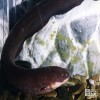Electrophorus electricus
The electric eel can be up to 91 inches in length, with a weight of up to 100 pounds. The body is long, rounded and smooth. They are air breathers. The gastric cavity and internal organs are immediately behind the head, and only the swim bladder extends far to the rear. The main body is formed by a long “tail” or rear portion, generally lacking a caudal fin or having just a trace of one. The anus is well forward, located under the pectoral fin or on the throat. The dorsal fin is either greatly decreased in size or absent altogether; in some species without a caudal fin, a fibrous structure replaces the dorsal fin. Pelvic fins are never present, and the pectoral fins are of various sizes. The anal fin is greatly elongated. It extends two-thirds or three-quarters of the entire length, and in one species proceeds around the finless tail to the upper side of the body. The eyes are degenerate (deteriotated structure) and generally have an additional eyelid as an adaptation to the nocturnal life. The gill openings are small. The swim bladder varies in shape but is usually in a bony capsule. The throat is large, with cylindrical teeth.
The electrical generating organ is composed of 5,000 to 6,000 elements, arranged like a dry battery. The head acts as the positive pole and the tail the negative pole. When the eel is at rest, there is no generation of electricity, but when it starts to move, it emits electrical impulses at the rate of about 25 per second. During intense feeding discharges of up to 50 per second have been recorded. These discharges aid in navigation, locating food, and the killing of prey. Small animals are killed outright, while large mammals become stunned and drown.

